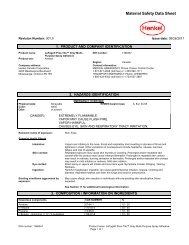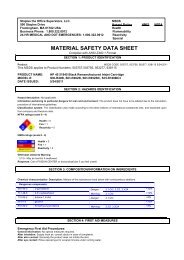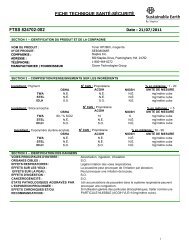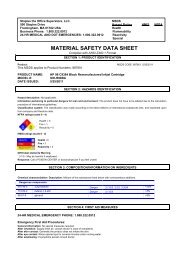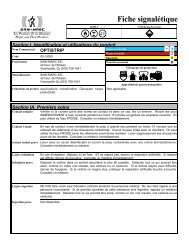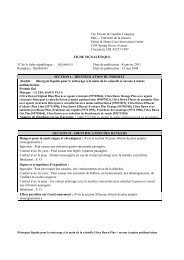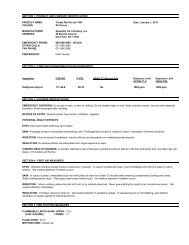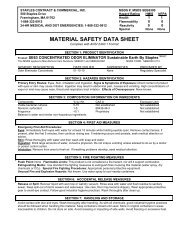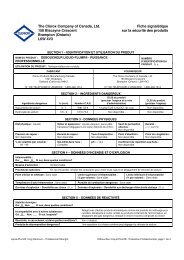1. chemical product and company identification - E-Way.ca
1. chemical product and company identification - E-Way.ca
1. chemical product and company identification - E-Way.ca
Create successful ePaper yourself
Turn your PDF publications into a flip-book with our unique Google optimized e-Paper software.
Material Safety Data SheetSodium Hypochlorite 5.25%<strong>1.</strong> CHEMICAL PRODUCT AND COMPANY IDENTIFICATIONProduct Id: 10001Product Name: Sodium Hypochlorite 5.25%Synonyms: NoneChemi<strong>ca</strong>l Family: Hydrochlorous acid, sodium salt.Appli<strong>ca</strong>tion: Not Available.Distributed By:Queen Bleach Co. Limited7419 Bren Rd.Mississauga, Ont. L4T-1H324-Hour Emergency Telephone Number Canutec: (613) 996-6666Prepared by: Queen Bleach Co. LimitedPreparation date: Jan 2, 2007.2. COMPOSITION/INFORMATION ON INGREDIENTSHAZARDOUS COMPONENTSIngredients Percentage LD50s <strong>and</strong> LC50s Route & Species:Sodium Hypochlorite, Solution 3-7 Oral LD50 (Mouse) 5800 mg/kgNON-HAZARDOUS COMPONENTSIngredients Percentage LD50s <strong>and</strong> LC50s Route & Species:Water Balance Not available.Notes: No additional remark.3. HAZARDS IDENTIFICATIONPotential Acute Health Effects:Eye Contact: Corrosive to eye tissue <strong>and</strong> may <strong>ca</strong>use severe damage <strong>and</strong> blindness. This<strong>product</strong> <strong>ca</strong>uses corneal sarring <strong>and</strong> clouding. Glaucoma. Cataracts.Skin Contact: Corrosive. Causes severe burns. Prolonged <strong>and</strong> repeated exposure to dilutesolutions often <strong>ca</strong>uses rritation, redness, pain <strong>and</strong> drying <strong>and</strong> cracking of the skin. Toxic effectsmay be delayed. Avoid h<strong>and</strong>ling when the skin is moist, wet or abraided. May <strong>ca</strong>use dermatitis,prolonged or repeated contact may <strong>ca</strong>use skin sensitization.Inhalation: Corrosive to respiratory passages. Causes irritation of the mouth, nose <strong>and</strong> throat.Repeated <strong>and</strong>/or prolonged exposures may <strong>ca</strong>use <strong>product</strong>ive cough, running nose,bronchopneumonia, pulmonary edema (fluid buildupPage 1 of 6
in lungs) <strong>and</strong> reduction of pulmonary function. If mixed with acids or warmed to temperaturesgreater than 40 degrees Celcius, Sodium hypochlorite solutions release chlorine gas. This gas<strong>ca</strong>n <strong>ca</strong>use severe irritation of the nose <strong>and</strong> throat. Exposures to high levels of chlorine gas mayresult in severe lung damage.Ingestion: Corrosive. Causes burns to the mouth, throat <strong>and</strong> stomach. Causes vomiting, nausea,<strong>and</strong> diarrhea. Coma, shock <strong>and</strong> death may occur.4. FIRST AID MEASURESEye Contact: Wash eyes with water for a minimum of 30 minutes or until no evidence of the<strong>chemi<strong>ca</strong>l</strong> remains. Hold eyelids open during flushing. Seek immediate medi<strong>ca</strong>l attention.Skin Contact: Remove contaminated clothing. Wash skin with water for at least 30 minutes,using soap if available. Obtain medi<strong>ca</strong>l attention immediately.Inhalation: Remove person to fresh air. If not breathing, give artificial respiration. If breathing isdifficult, get immediate medi<strong>ca</strong>l attention.Ingestion: Rinse mouth with water. Do not induce vomiting. Do not give anything by mouth to anunconscious person. If vomiting occurs spontaneously, keep head below hips to preventaspiration of liquid into the lungs. Seek immediate medi<strong>ca</strong>l attention.Notes To Physician: Due to the severely irritating or corrosive nature of the material, swallowingmay lead to ulceration <strong>and</strong> inflammation of the upper alimentary tract with hemorrhage <strong>and</strong> fluidloss. Also, perforation of the esophagus or stomach may occur, leading to mediastinitis orperitonitis <strong>and</strong> the resultant compli<strong>ca</strong>tions.5. FIRE FIGHTING MEASURESFlash Point: None - will not burn.Flash Point Method: Not appli<strong>ca</strong>ble.Autoignition Temperature: Not appli<strong>ca</strong>ble.Flammable Limits in Air (%): Not appli<strong>ca</strong>ble.Extinguishing Media: Use extinguishing media appropriate for surrounding fire.Special Exposure Hazards: Keep containers cool to prevent rupture <strong>and</strong> release of material.Closed containers may explode in fire. Spilled material may <strong>ca</strong>use floors <strong>and</strong> contact surfaces tobecome slippery.Special Protective Equipment: Fire fighters should wear full protective clothing, including selfcontainedbreathing equipment.NFPA RATINGS FOR THIS PRODUCT ARE: Not Available.HMIS RATINGS FOR THIS PRODUCT ARE: Not Available.6. ACCIDENTAL RELEASE MEASURESPersonal Pre<strong>ca</strong>utionary Measures: Wear appropriate protective equipment.Environmental Pre<strong>ca</strong>utionary Measures: Prevent from entering sewers, waterways or lowareas. Prevent contamination of soil. Consult lo<strong>ca</strong>l authorities.Procedure for Clean Up: Absorb with an inert dry material <strong>and</strong> place in an appropriate wastedisposal container. Spilled material may <strong>ca</strong>use floors <strong>and</strong> contact surfaces to become slippery.Dike <strong>and</strong> contain l<strong>and</strong> spills; contain water spills by booming. Ventilate area.7. HANDLING AND STORAGEH<strong>and</strong>ling: Use good personal hygiene. Use appropriate personnel protective equipment. Usewith adequate ventilation. Containers which have been exposed to heat may be under internalpressure. These should be cooled <strong>and</strong> <strong>ca</strong>refully vented before opening. When diluting, add this<strong>product</strong> to water in small amounts to avoid spattering. Never add water to this material.Storage: Equipment for storage, h<strong>and</strong>ling or transporation should not be made of: tin, copper <strong>and</strong>its alloys, nickel <strong>and</strong> its alloys <strong>and</strong> iron. Some metals accelerate the decomposition of SodiumHypochlorite. Store below 29 Degrees Celsius. Do not freeze. Store in a cool, dry, well ventilatedarea, away from heat <strong>and</strong> ignition sources. Store away from organic <strong>chemi<strong>ca</strong>l</strong>s, strong bases,Page 2 of 6
metal powders, <strong>ca</strong>rbides, sulfides, <strong>and</strong> any readily oxidizable material. Keep away from directsunlight. Storage area should be equipped with corrosion-resistant floors, sumps <strong>and</strong> should havecontrolled drainage to a recovery tank.8. EXPOSURE CONTROLS/PERSONAL PROTECTIONEngineering Controls: Lo<strong>ca</strong>l exhaust ventilation as necessary to maintain exposures to withinappli<strong>ca</strong>ble limits. Make up air should always be supplied to balance air exhausted (eithergenerally or lo<strong>ca</strong>lly). For personnel entry into confined spaces (i.e. bulk storage tanks) a properconfined space entry procedure must be followed including ventilation <strong>and</strong> testing of tankatmosphere. Ventilation should be corrosive proof.Respiratory Protection: Wear a Niosh approved full facepiece respirator for acid gases or a selfcontainedbreathing apparatus for air concentration levels up to 5 ppm. NIOSH approved suppliedair respirator when airborne concentrations exceed exposure limits.Gloves: Impervious gloves. Neoprene gloves. Nitrile gloves. Rubber gloves.Skin Protection: Neoprene coated apron or <strong>chemi<strong>ca</strong>l</strong> resistant clothing. Impervious boots.Eyes: Chemi<strong>ca</strong>l safety goggles <strong>and</strong>/or full face shield to protect eyes <strong>and</strong> face, if <strong>product</strong> ish<strong>and</strong>led such that it could be splashed into eyes. Do NOT wear contact lenses.Other Personal Protection Data: Ensure that eyewash stations <strong>and</strong> safety showers are proximalto the work-station lo<strong>ca</strong>tion.Ingredients Percentage Exposure Limit -ACGIHExposure Limit - OSHASodium Hypochlorite, 3-7 0.5 ppm As For . Not available.SolutionChlorineWater Balance Not available. Not available.9. PHYSICAL AND CHEMICAL PROPERTIESPhysi<strong>ca</strong>l State: LiquidColor: Green to yellow.Odor: Typi<strong>ca</strong>l chlorine bleach.pH 1<strong>1.</strong>5 - 13Specific Gravity: <strong>1.</strong>076Boiling Point (°C): 101Freezing/Melting Point (°C): -4Vapor Pressure (mm Hg): 22 @ 20 °CVapor Density: Not Available.% Volatile by Volume: 91Evaporation Rate: Not Available.Solubility: Soluble.VOCs (lbs/gallon): NoneViscosity: Water typeMolecular Weight: Not Available.10. STABILITY AND REACTIVITYChemi<strong>ca</strong>l Stability: Unstable.Hazardous Polymerization: Will not occur.Conditions to Avoid: Avoid excessive heat, open flames <strong>and</strong> all ignition sources.Materials to Avoid: Strong oxidizers. Reducing agents. Ammonia.Hazardous Decomposition Products: When heated to decomposition, it emits acrid smoke <strong>and</strong>irritating fumes. Chlorine. Oxides of sodium. Oxygen. Sodium Hypochlorite solutions decomposeslowly. Decomposition is accelerated by heat (temperatures above 40 degrees Celcius) <strong>and</strong> light.Additional Information: Hypochlorites may react with primary amines to form nitrogen trichloridewhich explodes spontaneously in air. Hypochlorite bleach reacts with urea to form nitrogentrichloride whic explodes spontaneously in air. Some metals accelarate the decomposition ofSodium Hypochlorite. Nickel. Copper. Tin. Iron <strong>and</strong> its alloys. Manganese.Page 3 of 6
1<strong>1.</strong> TOXICOLOGICAL INFORMATIONPrinciple Routes of ExposureIngestion: Corrosive. Causes burns to the mouth, throat <strong>and</strong> stomach. Causes vomiting, nausea,<strong>and</strong> diarrhea. Coma, shock <strong>and</strong> death may occur.Skin Contact: Corrosive. Causes severe burns. Prolonged <strong>and</strong> repeated exposure to dilutesolutions often <strong>ca</strong>uses irritation, redness, pain <strong>and</strong> drying <strong>and</strong> cracking of the skin. Toxic effectsmay be delayed. Avoid h<strong>and</strong>ling when the skin is moist, wet or abraided. May <strong>ca</strong>use dermatitis,prolonged or repeated contact may <strong>ca</strong>use skin sensitization.Inhalation: Corrosive to respiratory passages. Causes irritation of the mouth, nose <strong>and</strong> throat.Repeated <strong>and</strong>/or prolonged exposures may <strong>ca</strong>use <strong>product</strong>ive cough, running nose,bronchopneumonia, pulmonary edema (fluid buildup in lungs) <strong>and</strong> reduction of pulmonaryfunction. If mixed with acids or warmed to temperatures greater than 40 degrees Celcius, Sodiumhypochlorite solutions release chlorine gas. This gas <strong>ca</strong>n <strong>ca</strong>use severe irritation of the nose<strong>and</strong> throat. Exposures to high levels of chlorine gas may result in severe lung damage.Eye Contact: Corrosive to eye tissue <strong>and</strong> may <strong>ca</strong>use severe damage <strong>and</strong> blindness. This<strong>product</strong> <strong>ca</strong>uses corneal s<strong>ca</strong>rring <strong>and</strong> clouding. Glaucoma. Cataracts.Additional Information:Sodium hydrochlorite may <strong>ca</strong>use skin sensitization or other allergic responses. Aspiration may<strong>ca</strong>use lung damage. Corrosive effects on the skin <strong>and</strong> eyes may be delayed, <strong>and</strong> damage mayoccur without the sensation or onset of pain.Acute Test of Product:Acute Oral LD50: Not Available.Acute Dermal LD50: Not Available.Acute Inhalation LC50: Not Available.Carcinogenicity:Ingredients IARC –Carcinogens ACGIH -CarcinogensSodium Hypochlorite, Not listed.Not listed.SolutionWater Not listed. Not listed.Carcinogenicity Comment: No additional information available.Genotoxicity: Not Available.Re<strong>product</strong>ive/Developmental Toxicity: Not Available.Teratogenicity: Not Available.Embryotoxicity: Not Available.Mutagenicity: Not Available.12. ECOLOGICAL INFORMATIONEcotoxicologi<strong>ca</strong>l Information:Ingredients Ecotoxicity -Fish SpeciesDataSodium Hypochlorite,SolutionAcute CrustaceansToxicity:Ecotoxicity – FreshwaterAlgae DataNot Available. Not Available. Not Available.Not Available.Water Not Available. Not Available. Not Available.Other Information: Harmful to aquatic life at low concentrations. Toxicity is primarily associatedwith pH.Page 4 of 6
13. DISPOSAL CONSIDERATIONSDisposal of Waste Method: Disposal of all wastes must be done in accordance with municipal,provincial <strong>and</strong> federalregulations.Contaminated Packaging: Empty containers retain <strong>product</strong> residue (liquid <strong>and</strong>/or vapour) <strong>and</strong><strong>ca</strong>n be dangerous. Donot expose such containers to heat, flame, sparks, static electricity or other sources of ignition;they may explode. Donot dispose of package until throughly washed out. Dispose of container according to national orlo<strong>ca</strong>l regulations.14. TRANSPORT INFORMATIONDOT (U.S.):DOT Shipping Name: CORROSIVE LIQUID, N.O.S. (SODIUM HYPOCHLORITE)DOT Hazardous Class 8DOT UN Number: UN1760DOT Packing Group: IIIDOT Reportable Quantity (lbs): Not Appli<strong>ca</strong>ble.Marine Pollutant: No.ICAO/IATA:IATA Proper Shipping Name: CORROSIVE LIQUID, N.O.S. (SODIUM HYPOCHLORITE)IATA Hazard Class: 8UN/NA Number: UN1760Packing Group: IIIIATA Label: Corrosive.Remarks: No additional remark.IMDG:IMDG Proper Shipping Name: CORROSIVE LIQUID, N.O.S. (SODIUM HYPOCHLORITE)Hazard Class: 8Packing Group: IIIMarine Pollutant: No.IMDG Label: Corrosive.Remarks: No additional remark.TDG (Canada):TDG Proper Shipping Name: CORROSIVE LIQUID N.O.S (sodium hypochlorite)Hazard Class: 8UN Number: UN1760Packing Group: IIINote: No additional remark.Marine Pollutant: No.15. REGULATORY INFORMATIONU.S. TSCA Inventory Status: All components of this <strong>product</strong> are either on theToxic SubstancesControl Act (TSCA)Inventory List or exempt.Canadian DSL Inventory Status: All components of this <strong>product</strong> are either on the DomesticSubstances List (DSL) orthe Non-Domestic Substances List (NDSL) or exempt.Page 5 of 6
U.S. Regulatory RulesIngredientsCERCLA/SARA– Section 302:SARA (311, 312)Hazard Class:CERCLA/SARA - Section313:Sodium Hypochlorite,SolutionNot Listed. LISTED Not Listed.Water Not Listed. Not Listed. Not Listed.California Proposition 65: Not Listed.MA Right to Know List: Listed.New Jersey Right-to-Know List: Listed.Pennsylvania Right to Know List: Listed.WHMIS Hazardous Class:D2B TOXIC MATERIALSE CORROSIVE MATERIAL16. OTHER INFORMATIONAdditional Information: This <strong>product</strong> has been classified in accordance with the hazard criteriaof theCanadian Controlled Products Regulations (CPR) <strong>and</strong> the MSDS contains all theinformation required by the CPR.Disclaimer: NOTICE TO READER:Queen Bleach, expressly disclaims all express or implied warranties of merchantability <strong>and</strong>fitness for a particular purpose, with respect to the <strong>product</strong> or information providedherein, <strong>and</strong> shall under no circumstances be liable for incidental or consequentialdamages. Do not use ingredient information <strong>and</strong>/or ingredient percentages in this MSDS as a<strong>product</strong> specifi<strong>ca</strong>tion. For <strong>product</strong> specifi<strong>ca</strong>tion information refer to a ProductSpecifi<strong>ca</strong>tion Sheet <strong>and</strong>/or a Certifi<strong>ca</strong>te of Analysis. These <strong>ca</strong>n be obtained fromyour lo<strong>ca</strong>l Queen Bleach Sales Office.All information appearing herein is based upon data obtained from themanufacturer <strong>and</strong>/or recognized techni<strong>ca</strong>l sources. While the information isbelieved to be accurate, Queen Bleach makes no representations as to its accuracy orsufficiency. Conditions of use are beyond Queen Bleach’scontrol <strong>and</strong> therefore users areresponsible to verify this data under their own operating conditions to determinewhether the <strong>product</strong> is suitable for their particular purposes <strong>and</strong> they assume allrisks of their use, h<strong>and</strong>ling, <strong>and</strong> disposal of the <strong>product</strong>, or from the publi<strong>ca</strong>tion oruse of, or reliance upon, information contained herein. This information relates onlyto the <strong>product</strong> designated herein, <strong>and</strong> does not relate to its use in combination withany other material or in any other process.***END OF MSDS***Page 6 of 6




